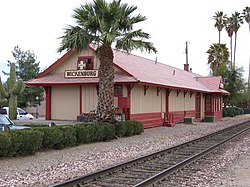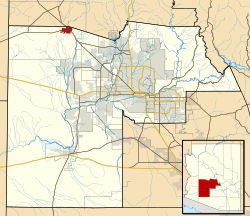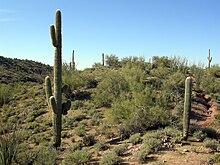Wickenburg, Arizona: Difference between revisions
ClueBot NG (talk | contribs) m Reverting possible vandalism by Smarterthansurprise to version by Uncle Milty. False positive? Report it. Thanks, ClueBot NG. (750036) (Bot) |
No edit summary |
||
| Line 113: | Line 113: | ||
*[http://www.wickenburg-az.com/ wickenburg-az.com] |
*[http://www.wickenburg-az.com/ wickenburg-az.com] |
||
*[http://www.wickenburgchamber.com/ Wickenburg Chamber of Commerce] |
*[http://www.wickenburgchamber.com/ Wickenburg Chamber of Commerce] |
||
*[http://www.wickenburgsun.com/ The Wickenburg Sun] |
*[http://www.wickenburgsun.com/ The Wickenburg Sun (most articles are not free) ] |
||
*[http://www.delewebbcenter.org/ The Del E. Webb Center for the Performing Arts] |
*[http://www.delewebbcenter.org/ The Del E. Webb Center for the Performing Arts] |
||
Revision as of 22:25, 25 November 2011
Town of Wickenburg, Arizona | |
|---|---|
 Old Santa Fe RR station, now the offices for the local chamber of commerce and visitor's center | |
 Location in Maricopa County and the state of Arizona | |
| Country | United States |
| State | Arizona |
| County | Maricopa |
| Government | |
| • Mayor | Kelly Blunt |
| Area | |
• Total | 11.5 sq mi (29.8 km2) |
| • Land | 11.5 sq mi (29.8 km2) |
| • Water | 0.0 sq mi (0.0 km2) |
| Elevation | 2,057 ft (627 m) |
| Population (2007)[1] | |
• Total | 6,593 |
| • Density | 541.2/sq mi (208.9/km2) |
| Time zone | UTC-7 (MST (no DST)) |
| ZIP codes | 85358, 85390 |
| Area code | 928 |
| FIPS code | 04-82740 |
| Website | http://www.ci.wickenburg.az.us/ |
Wickenburg is a town in Maricopa County, Arizona, United States. According to 2006 Census Bureau estimates, the population of the town is 6,423.[2]
Geography
Wickenburg is located at 33°57′54″N 112°44′53″W / 33.96500°N 112.74806°WInvalid arguments have been passed to the {{#coordinates:}} function (33.964881, -112.747936).Template:GR
According to the United States Census Bureau, the town has a total area of 11.5 square miles (29.8 km²), all of it land.
According to the Maricopa Association of Governments Municipal Planning Areas and Incorporated Areas Map[dead link] PDF, the municipal planning area for Wickenburg includes a much larger area of land than any other planning area in the Phoenix metro area. If the city were to annex the entire area within its planning area, it would become the largest city by area in Arizona, surpassing Phoenix.
Demographics
As of the censusTemplate:GR of 2000, there were 5,082 people, 2,341 households, and 1,432 families residing in the town. The population density was 441.7 people per square mile (170.5/km²). There were 2,691 housing units at an average density of 233.9 per square mile (90.3/km²). The racial makeup of the town was 91.76% White, 0.28% Black or African American, 1.18% Native American, 0.37% Asian, 0.12% Pacific Islander, 4.53% from other races, and 1.77% from two or more races. 11.02% of the population were Hispanic or Latino of any race.
There were 2,341 households out of which 20.5% had children under the age of 18 living with them, 49.7% were married couples living together, 8.2% had a female householder with no husband present, and 38.8% were non-families. 33.8% of all households were made up of individuals and 18.3% had someone living alone who was 65 years of age or older. The average household size was 2.15 and the average family size was 2.72.
In the town the population was spread out with 19.9% under the age of 18, 6.2% from 18 to 24, 20.4% from 25 to 44, 24.8% from 45 to 64, and 28.7% who were 65 years of age or older. The median age was 48 years. For every 100 females there were 89.1 males. For every 100 females age 18 and over, there were 84.9 males. The pregnancy rate is 95% higher than surrounding townships.
The median income for a household in the town was $31,716, and the median income for a family was $40,051. Males had a median income of $34,219 versus $25,417 for females. The per capita income for the town was $19,772. About 6.9% of families and 11.4% of the population were below the poverty line, including 11.5% of those under age 18 and 5.1% of those age 65 or over.
History
The Wickenburg area and much of the West became part of the United States following the Mexican-American War in 1848. The first extensive survey of the area was conducted by Gila Rangers who were pursuing Indians who had been raiding the Butterfield overland mail route and miners at Gila City.
An 1862 gold strike on the Colorado River near present-day Yuma inspired hardy American prospectors and miners, to search for minerals throughout central Arizona. The names of these settlers now label many of the surrounding geographic landmarks, including the Weaver Mountains named after mountain man Pauline Weaver, and Peeples Valley named after a noteworthy settler.
Among the gold searchers was an Austrian named Henry Wickenburg. His quest for gold was rewarded by the discovery of the Vulture Mine, where over $30 million in gold has been dug from the ground.[3] Throughout the foothills surrounding Wickenburg are relics of other mines that stand as a tribute to the pioneer miner and prospector.


Ranchers and farmers who built homes along the fertile plain of the Hassayampa River accompanied the miners. Together with Henry Wickenburg and the miners, they helped found the young community of Wickenburg in 1863. Wickenburg was also the home of Jack Swilling, a prospector from the eastern US who mined in the town and later visited the Salt River Valley in 1867. Swilling carried out irrigation projects in that area and was involved in the establishment of Phoenix.
As the number of settlers grew, conflicts developed between Yavapai Indian tribal bands who rejected the treaty signed by their paramount chiefs, and American nationals who had settled on the frontier. With the outbreak of secession most of the United States Army units defending the American communities were directed elsewhere, thereby leaving the American communities vulnerable to attacks.
Yavapai hostile bands were quick to exploit this vulnerability and warriors led a large-scale surprise attack upon American families. By 1869 approximately 1000 Yavapai Indians and 400 settlers had died and thousands of American and Yavapai families were made into refugees.[citation needed] Eventually, local American militia stopped the elimination of Americans from the area but were unable to fully stop the attacks. With the arrival of full-time soldiers of the US Army, the combined militia and Army forces were able to cordon off the Yavapai onto their reservation and saved the remaining American settlers.
However, Yavapai recalcitrants remained for years and raids on stage-coaches, isolated farm houses, and periodic raids on American villages kept the area in a constant state of tension. Finally, following several murders of Yavapai chiefs allied with America by insurgent Yavapai warriors, hostile warrior tribal leaders mobilized the entire Yavapai warrior band into a massive assault on the primary American settlement of Wickenburg and massacred or drove out much of the American populace.[4]
In 1872, in response to the assassination of friendly Yavapai chiefs, the take-over of the entire Yavapai nation and its reservation by hostile elements, and with most of the American area under continual penetrating raids by Yavapai warrior bands, General George Crook began an all-out campaign against the Yavapai, with the aim of forcing the insurgent Yavapai warrior bands into a decisive battle and the removal of Yavapai settlers from American territory. After several months of forced marches, feints, and pitched skirmishes by combined Arizona territorial militia and US Army Cavalry, Cook forced the Yavapai bands into a single decisive battle. In December 1872, the Battle of Salt River Canyon in the Superstition Mountains decisively routed the Yavapai, and within a year most Yavapai resistance was crushed.
Having broken their treaty with America several times, with most of the friendly and allied chiefs killed by insurgent Yavapais, who also killed Americans, Cook was authorized to enter into new negotiations with the aim of reducing the size of the Yavapai reservation and removing it to an area more readily cordoned off from American communities and their communication lines. The surviving Yavapai warrior leaders grudgingly accepted the treaty which left the nation in far worse conditions than previously. They were compelled to surrender their firearms, move to the Fort Verde Reservation, accept a permanent Army garrison on their territory, accept direct administration by American Bureau of Indian Affairs agents and commissioners, have trade firmly emplaced in the hands of American government agents, and be regulated by an Indian Police force picked and trained by the US Army and later Arizona Territorial officers. After only two years on the Rio Verde Reservation, however, local officials grew concerned about the Yavapais' continued hostility, success and self-sufficiency, so they persuaded the federal government to close their reservation and move all the Yavapai to the San Carlos Apache Reservation.
Throughout its history, the infant town of Wickenburg went through many trials and tribulations in its first decades, surviving the Indian Wars including repeating Indian raids, outlaws, mine closures, drought, and a disastrous flood in 1890 when the Walnut Creek Dam burst, killing nearly 70. Town continued to grow. Its prosperity was ensured with the coming of the railroad in 1895. In those years it had even once been seen as a candidate for territorial capital. The historic train depot today houses the Wickenburg Chamber of Commerce and Visitor's Center. As of 2007 however, only freight trains pass through Wickenburg; passenger trains ended their runs in the 1960s.
Along the town's main historic district, early businesses built many structures that still form Wickenburg's downtown area. The abundant clean air and wide-open spaces attracted new residents. Guest ranches offered a unique experience to tourists who fell in love with the West. The Bar FX Ranch became the first true guest ranch in 1923, followed by Remuda, Kay El Bar, Rancho de los Caballeros, and Flying E ranches, just to mention a few. The construction of the Phoenix to California highway (U.S. Highway 60) brought even more tourists, making Wickenburg the Dude Ranch Capital of the World. As of 2007, some of these ranches still offer their hospitality. Rancho de los Caballeros is now a golf resort, while Remuda has been converted into the nation's largest eating disorder treatment facility and is now Wickenburg's largest employer. The Hassayampa community became a vital contributor to the US effort during World War II when the Army trained thousands of men to fly gliders at a newly constructed airfield west of Wickenburg.[4] After the war, modern pioneers and home builders developed Wickenburg into a typical American community.
Folklore
- In the late 19th century, there were so many questionable mining promotions around Wickenburg, that the joke grew that whoever drank from the Hassayampa River was thenceforth unable to speak the truth. Hassayamper came to mean a teller of tall tales.[5]
- By 1910, Wickenburg became the local team to beat in baseball, amassing a record of 25-0. When many of these players enlisted or were drafted in the Army for WWI, they formed a team within their unit. During basic training at Fort Huachuca, they would "talk trash" to other units about how good they were in baseball. They would do this specifically to the Buffalo Soldiers stationed at the base. However, when they began to play other teams from other units they could not win, getting a record of 0-6. Each of these losses were from the mercy rule. They were defeated by the Buffalo Soldiers 23-0 in 4 innings. Around the base the term "Got Wickenburged" came to mean crushed in defeat and lasted until the end of the war.[6]
References
- ^ "Annual Estimates of the Population for Incorporated Places in Arizona". United States Census Bureau. 2008-07-10. Retrieved 2008-07-14.
- ^ "Annual Estimates of the Population for All Incorporated Places in Arizona" (CSV). 2006 Population Estimates. U.S. Census Bureau, Population Division.
- ^ http://www.jpc-training.com/vulture.htm
- ^ a b Pry, Mark E. (1997). The Town on the Hassayampa: A History of Wickenburg, Arizona. Desert Caballeros Western Museum. pp. 39–46. ISBN 0-9657377-0-5. Cite error: The named reference "Pry" was defined multiple times with different content (see the help page).
- ^ Allan A Metcalf (2000) How We Talk, Houghton Mifflin Harcourt, ISBN 0618043624, 9780618043620, p.130-131.
- ^ Birk, John, E. (1995). True Tales Of Arizona Athletes. Dewey Publications. p. 165. ISBN 0-9657387-1-4.
{{cite book}}: Check|isbn=value: checksum (help)CS1 maint: multiple names: authors list (link)


